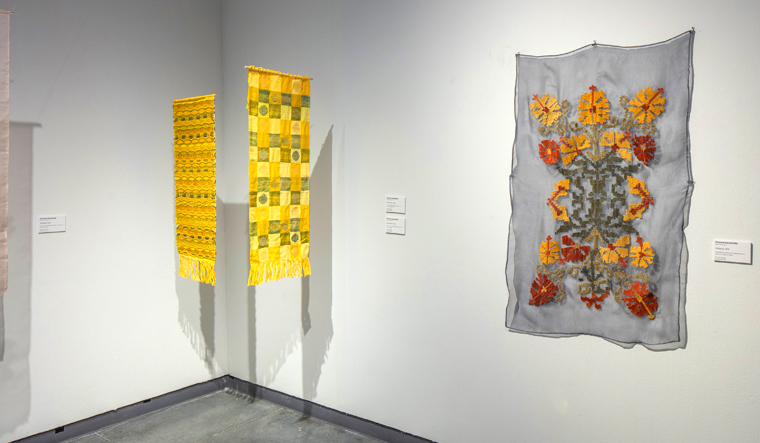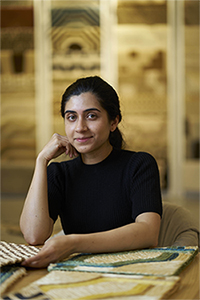Pallavi Padukone
Olfactory art is a form of contemporary art that engages the sense of smell as a medium. Like visual and auditory arts, olfactory art seeks to communicate ideas, emotions, or experiences through sensory stimuli, specifically through scents. It offers a unique and powerful way to engage with memories and nostalgia by tapping into the senses to create evocative experiences that resonate with viewers on a visceral level. The use of scent as a primary medium in art is a relatively new and evolving field, leaving ample room for innovation, and offering a vast playground for creativity, experimentation, and exploration. Creating a scent profile associated with color, food and flora can play a significant role in shaping cultural identity through nostalgia.
Pallavi Padukone, a textile artist from Bengaluru is exploring the combination of scent and textiles. Textiles have long been used as a medium for storytelling. Whether through traditional techniques or contemporary innovations, textiles continue to be a rich and vibrant form of cultural expression. Combining textiles with scent, can add a layer of depth and complexity to an artwork, much like texture or color. Reinterpreting the fragrance industry, her experimental sensorial collection, Reminiscent, uses natural ways to integrate and infuse scents into handmade textiles through weaving and embroidery with scented materials. Her initial source of inspiration was the calming effect of a small pouch of lavender, while being cooped up in her apartment during the lockdown in 2020. This gave her the idea to further explore the concept of scents for wellness by integrating them as a form of embellishment in her textiles. The thought of textiles enveloping you in a comforting fragrance could almost feel like a warm hug. Reminiscent, she believes, is her way of using textile art to condense time and distance and reconnect with nature, nostalgia, home, and identity.
Collaborating with nature she was able to develop a natural coating for yarn and beads to capture scents, using beeswax, tree resin, essential oils, and earth pigments. Pallavi’s work is guided by craft, using techniques of hand weaving, embroidery, and natural dyeing. She integrates hand-spun recycled silk sourced from old saris mixed with scent coated cotton for her weaves. With vetiver, she works with the fragrant root itself. It releases the most divine woody scent when activated with water. She has been inspired by the traditional Indian use of ‘khus’ as a natural air cooler, where it is matted and wet felted onto windows, using embroidery as a technique to tame the vetiver root, while retaining its natural wildness. Her more recent pieces explore the scent profile associated with the emotion of comfort. Her pieces ‘Jasmine’, ‘Hibiscus’, ‘Spice Rack’ and ‘After the Rains’ are all stemmed from fragrances that she associates with her childhood home. The sweet-smelling jasmine buds in the terrace garden, the smell of clove and cardamom wafting from her morning chai, the petrichor-like scent of the vetiver root (khus), reminiscent of Bangalore’s summer showers. Each fragrance is seeped with nostalgia. For her embroidered piece titled ‘Hibiscus’ reminiscent of the vibrant flower in shades of buttery yellow and jam red growing in her grandmother’s garden– she interprets the flower’s scent using color and memory as tools to create a concoction of sweet pomegranate with notes of earthy sandalwood. Each fragrance in her collection represents a different color palette and is translated through handwoven and embroidered wall hangings and tapestries.
One of the perplexing qualities of olfactory art is its ephemeral nature. Unlike visual or auditory
works, smells are transient and can quickly dissipate, making the preservation and documentation of olfactory art more challenging. While the fragrances on her pieces continue to remain anywhere up to three months, depending on their exposure to heat and light, the impermanence is a reminder of its completely natural state and the fleeting and impermanent nature of time itself. Born during the period when wearing masks became the new normal, and we tend to take our sense of smell for granted, her collection pays tribute to this powerful sensorial experience and its effect on our wellness.
Reminiscent is an ongoing exploration as Pallavi plans to continue growing her archive of scents. Her work was exhibited at New York Textile Month and at the Delaware Contemporary as part of their group exhibition- Remembrances, Recollections and Retrospect and was also featured in Mental Floss Magazine, This is Colossal and the Times of India. Pallavi currently works as a rug designer and textile artist in New York.



